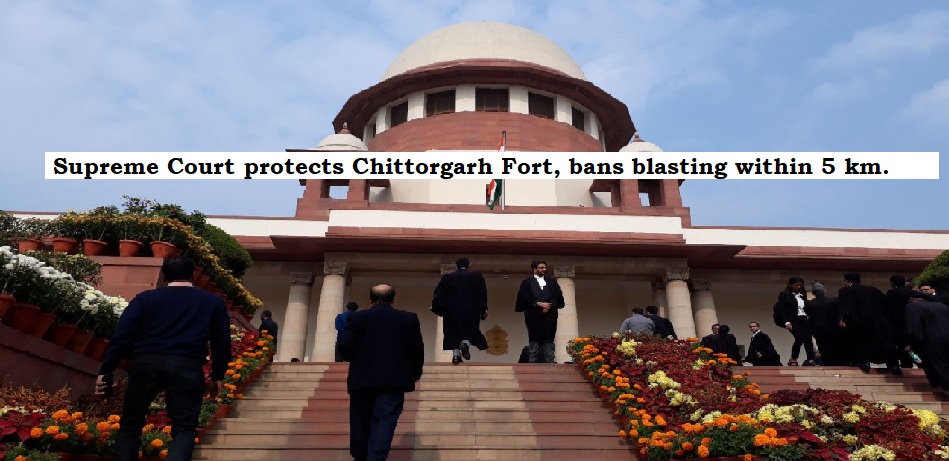


The Supreme Court, in a significant move, has intervened to safeguard the historical and cultural heritage of the Chittorgarh Fort in Rajasthan. The court issued directives on January 12th, highlighting the need for the fort's protection against the detrimental effects of blasting activities within a 5-kilometer radius, particularly concerning the mining of limestone and other minerals.
Cognizant of the rich history and legacy associated with the Chittorgarh Fort, the Supreme Court's order explicitly stated that no mining by blasting or the use of explosives for extracting minerals would be permitted within a radius of five kilometers from the fort's compound wall. The court expressed concerns about the continuous exposure of ancient monuments to peak particle velocity (PPV) resulting from blasting activities.
However, the order did not impose a complete ban on mining operations within the specified radius. Instead, it allowed manual and mechanical mining operations to continue, provided the lessee possesses a valid lease under the law. This nuanced approach aims to balance the preservation of the fort with the economic interests associated with lawful mining activities.
In addition to these measures, the Supreme Court directed the formation of an Expert Committee within two weeks. This committee, to be constituted by the Chairman of the Indian Institute of Technology (Indian School of Mines) in Dhanbad, Jharkhand, will undertake a comprehensive study of environmental pollution and the impact of blasting operations on the fort, specifically beyond the 5-kilometer radius. The committee is expected to include a team of multi-disciplinary experts to ensure a thorough examination of the issues at hand.
The genesis of this legal intervention lies in the Rajasthan government's decision to grant mining leases for areas in proximity to the Chittorgarh Fort, known for its limestone-rich surroundings. The extraction of minerals, particularly through explosives and blasting operations, raised concerns about the fort's vulnerability to the peak particle velocity generated during such activities.
Residents of Chittorgarh took the matter to the Rajasthan High Court, seeking an injunction against blasting activities within a 10-kilometer radius of the fort. The High Court granted relief, prohibiting mining and blasting within the specified radius. Furthermore, invoking the polluter pays principle, the court directed mine holders, including the petitioner, Birla Corporation, to pay a compensation of INR 5 crores for the restoration of the fort, with 90 percent of the amount to be borne by Birla Corporation.
Challenged by these directives, Birla Corporation, holding a mining lease for an area approximately 4.5 kilometers from the fort's boundary, appealed to the Supreme Court. The apex court, while issuing notice, observed that the question of a complete ban on mining operations around the fort, even without the involvement of blasting, was not addressed by the High Court.
To gather more information and assess the safety aspects, the Supreme Court mandated the Central Building Research Institute (CBRI) in Roorkee to conduct a comprehensive study. However, the report submitted by CBRI, Roorkee, conflicted with another report presented by the Ministry of Coal and Mines, Indian Bureau of Mines, Mining Research Cell. The court found this inconsistency troubling and emphasized the need for a detailed study exploring the latest techniques and technologies.
In light of these developments, the Supreme Court expressed a preference for a third-party institution and experts in the field to independently undertake the study. The court emphasized that advancements in scientific and technological methods should not be ignored unless proven ineffective through a comprehensive examination by a committee constituted by the court.
It is noteworthy that the CBRI, Roorkee's report highlighted additional factors contributing to the fort's deterioration, such as money menace, human/tourist footfall, unwanted vegetation growth, and the defacing of statues. In response, the Supreme Court issued directives to the Rajasthan government and the State Pollution Control Board to ensure strict implementation of the Solid Waste Management Rules, 2016, and take necessary steps to address unauthorized littering in the fort area and the issue of monkey menace.
In conclusion, the Supreme Court's proactive stance in safeguarding the Chittorgarh Fort underscores the delicate balance between preserving cultural heritage and addressing economic interests. The directives issued aim to ensure a comprehensive and independent evaluation of the environmental impact, setting the stage for informed and equitable decisions concerning the future of the Chittorgarh Fort and its surroundings.
TAGS: Supreme Court Chittorgarh Fort Blasting activities Mining Limestone